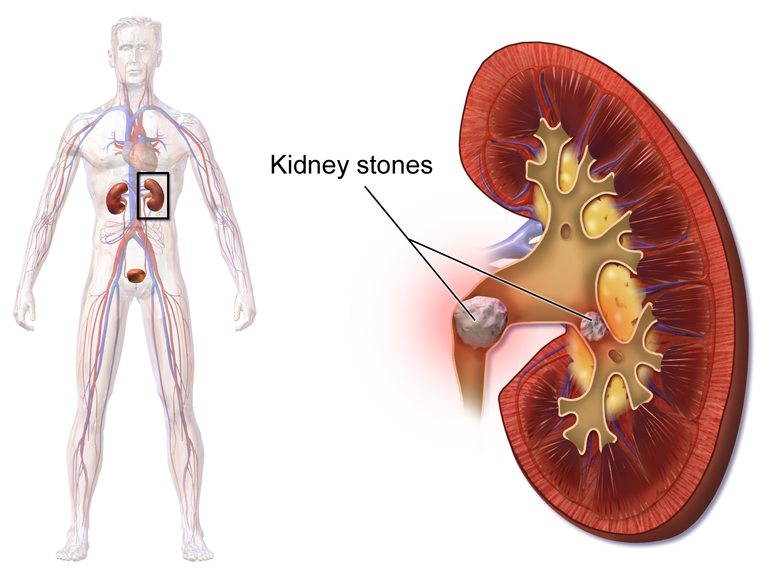Kidney Stone Explained - Cause, Treatment, and Prevention
Introduction to Kidney Stones
You must have heard about Kidney Stones, but do not tell me that you really believe in the myth that kidney stones occur as a result of swallowing stones. I was talking to a friend, and he narrated how his grandmother who never had a first-time experience with kidney stones dished him the kidney stones myth. He said she told him that for every stone or sand, no matter how little you swallow, there is a small amount that isn't digested by your stomach, and might not be excreted with faecal matter, thereby living the only option to be that the stone goes into the blood, then to the kidney where it starts to block the kidney region. When I heard this, I was dazed. I tried to wrap my head around what could have led brought to life such a story or belief. Well, I am not his grandmother, and I am not going to be telling you myths that I cannot fact-check. Today, I will be explaining the Kidney stone, and I will do my best to give a precise explanation of this topic.
I have no personal experience (I haven't suffered from them) with kidney stones, so I cannot tell the intensity of the pain people feel since pain is subjective. Some people will feel the pain more intensely than others but the truth remains that the pain is intense.

Wikimedia Commons
Humans have two kidneys, the left kidney and the right kidney. The left kidney is slightly bigger and slightly higher in the body than the right kidney, as a result of the liver, and the location of the left kidney. The kidney performs a lot of functions in the body. The kidney function includes the removal of waste with urine, which includes getting rid of urea, resulting from the breakdown of protein, and uric acid from nucleic acid, regulating blood pressure, osmolality regulation, and maintaining pH. The kidney in basic words filters the blood by receiving unfiltered blood through the renal artery which takes unfiltered blood into the cortex of the kidney, where it is filtered and the blood returns to the body through the renal vein. The waste from the blood is transferred to the renal medulla where it goes into the renal pyramid, then to the renal papillae, then to the renal calyces, then to the renal pelvis, where the waste goes through the ureter, then the bladder where the urine is stored then sent to the urethra where the urine is removed from the body.
Kidney stones occur in the urinary tract in the collecting tubules. The stone can come in different forms, ranging from calcium oxalate stones, phosphate stones, cystine stones, urate stones, and struvite stones but calcium oxalate is the most common type of kidney stone. Kidney stones are formed as a result of supersaturation, from electrolytes such as calcium, sodium, and potassium, which attract water to themselves. The kidney while filtering the blood allows electrolytes to absorb water from the blood which helps to transport the waste. When the electrolytes in the kidneys are beyond the normal amount, then the electrolyte become supersaturated causing crystals to begin to form in the collecting tubules of the renal pyramid. When the crystal is form, they start to aggregate and become larger, thereby forming a stone. It could flow with urine till it reaches the ureter where it affects the process of peristalsis, making it difficult for urine difficult and causing pain.
Causes and Symptoms of Kidney Stones
Taking little water, use of medications such as aspirin, antacids, diuretics, antiretroviral medicines, and antibiotics, eating too much salt or sugar. People with family history of kidney stones are at a high risk of having kidney stone, people who are obesed, and people who had digestive surgery.
Patients who suffer from kidney stones poccess the following symptoms which includes severe lower back pain, fever, nausea, vomiting, chills, cloudy urination, and smelly urine. In cases where the kidney stone has blocked the ureter patients will experience diarrhoea, weakness, bloody urination.
Treatment and prevention of Kidney Stones
Treatment for kidney stones includes medications such as muscle relaxers that could help the muscle of the ureter relax, surgical procedures such as shockwave-lithotripsy, where the stone is pulverized, ureteroscopy, direct surgery in the kidney,and nephrolithotripsy.
Prevention of kidney stone would include controlling diets by eating food low in oxalate, proper hydration of water and not excessive cola, consuming more fruits and vegetables thereby reducing the acidity in urine, and reduction of salt intake.
Thanks for your contribution to the STEMsocial community. Feel free to join us on discord to get to know the rest of us!
Please consider delegating to the @stemsocial account (85% of the curation rewards are returned).
Thanks for including @stemsocial as a beneficiary, which gives you stronger support.
Congratulations @merrymercy! You have completed the following achievement on the Hive blockchain and have been rewarded with new badge(s):
Your next target is to reach 10000 upvotes.
You can view your badges on your board and compare yourself to others in the Ranking
If you no longer want to receive notifications, reply to this comment with the word
STOPSupport the HiveBuzz project. Vote for our proposal!
The problem with this disease is that it takes a long time to be solved, unless it is through surgery, which is fast.
But the presentation is usually very painful, when one of those stones moves. I have seen people faint due to this pain, the best thing, as in all diseases, is to avoid it with a healthy diet and ingest plenty of fluids.
It is usually common in older people, and the pain is generally described to be colicky, that is, it occurs in spasms. Also excess Calcium can cause it. Thanks for sharing